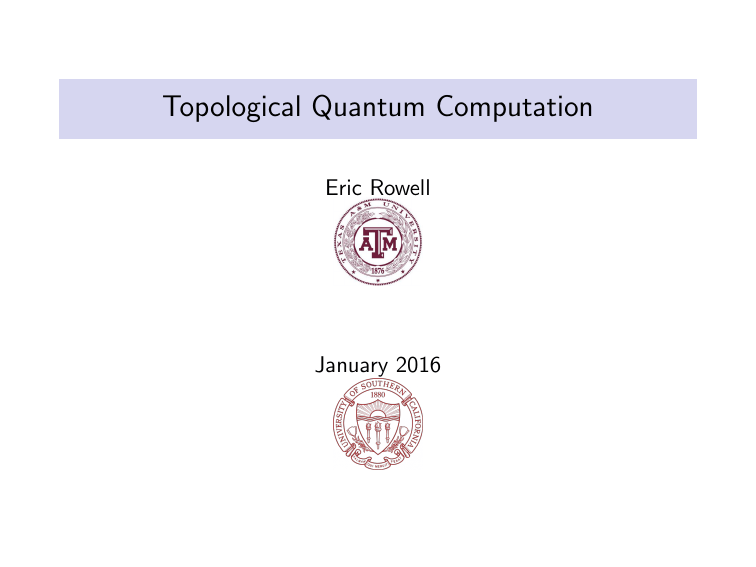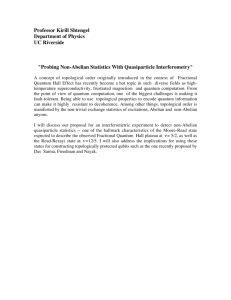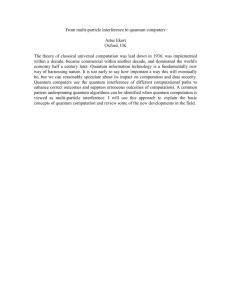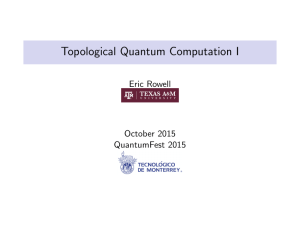Topological Quantum Computation Eric Rowell January 2016
advertisement

Topological Quantum Computation
Eric Rowell
January 2016
Texas A&M Research Team
Julia Plavnik,
Liang Chang:
Postdocs
Daniel Creamer, Paul Gustafson, Andrew Kimball and Qing Zhang:
PHD students
+2 Undergraduates: Humberto Munoz-Bauza and Chanwoo Kim
Topological Quantum Computation
Math
Physics
TQC
Computer
Science
Everything Else
What is a Quantum Computer?
From [Freedman-Kitaev-Larsen-Wang ’03]:
Definition
Quantum Computation is any computational model based upon
the theoretical ability to manufacture, manipulate and measure
quantum states.
Prototypical Quantum Computation Scheme
Fix a (classical) function f : Zn2 → Zn2 .
1. Goal: compute f (N).
2. Encode classical information N as a quantum state |Ni.
P
3. Process state: |Ni → j aj |ji depending on f .
4. Measure state: get |ji with probability |aj |2 , hopefully
|af (N) |2 0.
A Universal Quantum Circuit Model
Let V = C2 .
Example
I
I
I
state space (n-qubit): V ⊗n
1 0 0 0
0 1 0 0
quantum gate set: U1 :=
0 0 0 1 ,
0 0 1 0
1
0
1 1
1
√
U2 =
, U3 := 2
1 −1
0 e πi/4
Q ⊗aj
⊗b
quantum circuits: j IV ⊗ Uij ⊗ IV j ∈ U(V ⊗n ),
1 ≤ ij ≤ 3.
Theorem
Universal: n-qubit quantum circuits dense in SU(V ⊗n ).
Remarks on QCM
Remarks
I
Typical physical realization: composite of n identical d-level
systems. E.g. d = 2: spin- 12 arrays.
I
The setting of most quantum algorithms: e.g. Shor’s integer
factorization algorithm
I
Main nemesis: decoherence–errors due to interaction with
surrounding material. Requires expensive error-correction...
Question
How to overcome decoherence? One answer: TOPOLOGY.
The Braid Group
A key role is played by the braid group Bn generated by σi :
1
i
...
i+1
n
...
Definition (Artin)
Bn is generated by σi , i = 1, . . . , n − 1 satisfying:
(R1) σi σi+1 σi = σi+1 σi σi+1
(R2) σi σj = σj σi if |i − j| > 1
Anyons
For Point-like particles:
I
In R3 : bosons or fermions: ψ(z1 , z2 ) = ±ψ(z2 , z1 )
I
Particle exchange
R2 :
anyons: ψ(z1 , z2 ) = e iθ ψ(z2 , z1 )
I
In
I
Particle exchange
I
reps. of symmetric group Sn
Why? π1
(R3
reps. of braid group Bn
\ {zi }) = 1 but π1 (R2 \ {zi }) = Fn Free group.
=
C1
C2
C3
C1 6≈ C2 ≈ C3
Topological Phases of Matter/Anyons
Fractional Quantum Hall Liquid
1011 electrons/cm2
T 9 mK
quasi-particles
Bz 10 Tesla
Topological Quantum Computation (TQC) is a computational
model built upon systems of topological phases.
Topological Model
Computation
Physics
output
measure
(fusion)
apply gates
braid
anyons
initialize
create
anyons
vacuum
Mathematical Problems
1. Model for anyonic systems/topological phases
2. Classify (models of) topological phases
3. Interpret information-theoretic questions
4. 3-dimensional generalizations?
Modeling Anyons on Surfaces
Topology of marked surfaces+quantum mechanics“Marks”
(boundary components) are labelled by anyons, of which there are
finitely many (distinguishable, indecomposable).
Principle
Superposition: a state is a vector in a Hilbert space |ψi ∈ H.
Interpretation
b
a
c
→H
f
d
e
Principle
The composite state space of two physically separate systems A
and B is the tensor product HA ⊗ HB of their state spaces.
Interpretation
b
a
b
a
c
f
c
f
d
e
d
e
→H⊗H
Principle
Locality: the global state is determined from local information (on
disks, plus boundary conditions).
Interpretation
The Hilbert space of a marked surface M is a direct sum over all
boundary labelings of a surface Mg obtained by cutting M along a
circle.
b
a
c
H=
f
d
e
L
x
b
a
c
f
d
e
x*
x Hx
(x ∗ is anti-particle to x)
.
Definition (Nayak, et al ’08)
a system is in a topological phase if its low-energy effective field
theory is a topological quantum field theory (TQFT).
A 3D TQFT assigns to any surface (+boundary data `) a Hilbert
space:
(M, `) → H(M, `).
Each boundary circle
is labelled by i ∈ L a finite set of “colors”.
0 ∈ L is neutral. Orientation-reversing map: x → x ∗ .
Basic pieces
Any surface can be built from the following basic pieces:
(
C i =0
I disk: H(
; i) =
0 else
(
C a = b∗
I annulus: H(
; a, b) =
0 else
I pants:
◦
}
c
H(P; a, b, c) = CN(a,b,c)
P :=
a
b
Two more axioms
Axiom (Disjoint Union)
H[(M1 , `1 )
`
(M2 , `2 )] = H(M1 , `1 ) ⊗ H(M2 , `2 )
Axiom (Gluing)
If M is obtained from gluing two boundary circles of Mg together
then
M
H(M, `) =
H(Mg , `, x, x ∗ )
x∈L
b
a
c
x
f
b
a
c
f
x*
d
d
e
e
(M, `)
(Mg , `, x, x ∗ )
Algebraic Part=Modular Category
Morally, (2+1)TQFTs=Modular Categories:
Definition
A modular category C (over C) is
monoidal: (⊗, 1), L
semisimple: X ∼
= i mi Xi ,
linear: Hom(X , Y ) ∈ VecC ,
rigid: X ∗ ⊗ X 7→ 1 7→ X ⊗ X ∗ ,
finite rank: Irr (C) = {1 = X0 , . . . , Xr −1 },
spherical: uX θX : X ∼
= X ∗∗ , dim(X ) ∈ R,
braided: cX ,Y : X ⊗ Y ∼
= Y ⊗ X,
modular: Det(TrC (cXi ,Xj∗ cXj∗ ,Xi )) = Det(Sij ) 6= 0.
Key Data
I
L
fusion rules: Xi ⊗ Xj ∼
= k Nijk Xk
I
k
fusion ring representation: Xi → Ni where (Ni )k,j = Ni,j
I
(modular) S-matrix: Sij := TrC (cXi ,Xj∗ cXj∗ ,Xi )
I
(Dehn twist) T -matrix: Tij = δij θi
I
(quantum)Dimensions: dim(Xi ) := Si0 if unitary,
dim(Xi ) = max Spec(Ni ).
(2+1)TQFT Anyon Model vs Modular Category
Each axiom has a corresponding physical interpretation:
TQFT/anyonic system
anyon types x ∈ L
vacuum 0 ∈ L
x ∗ antiparticle
H(P; x, y , z) state space
particle exchange
anyon types observable
topological spin/Dehn twist
Category C
simple X
1
dual X ∗
Hom(X ⊗ Y , Z )
braiding cX ,X
det(S) 6= 0
θX
Example: Fibonacci Theory
I
L = {0, 1}
I
C
pants: H(P; a, b, c) = C
0
I
I
a=b=c
a + b + c ∈ 2Z
else
Define: Vki := H(D 2 \ {zi }ki=1 ; i, 1, · · · , 1)
(
Fib(n − 2) i = 0
dim Vni =
Fib(n − 1) i = 1
Classification
Question (Physics)
How many models exist for a given fixed number of distinguishable
indecomposable anyon types?
Theorem (Bruillard,Ng,R,Wang JAMS ’15)
There are finitely many modular categories of any given rank r .
Proof.
Recall Richard Ng’s colloquium at USC on March 12, 2014.
2 ≤rank≤ 5 fusion rules (Hong,Ng,Bruillard,Wang,Stong,R.):
|L|
2
3
4
5
C
PSU(2)3 , SU(2)1
Z3 , PSU(2)7 , SU(2)2
products, Z4 , PSU(2)9
Z5 , PSU(2)11 , SU(3)4 /Z3 , SU(2)4
Braid group representations
Bn acts on state spaces:
I
I
Fix anyons x, y
Braid group acts linearly:
Bn y H(D 2 \ {zi }; x, · · · , x, y ) = Hom(X ⊗n , Y )
by particle exchange
i
i+1
i
Universal Anyons
Question (Quantum Information)
When does an anyon x provide universal computation models?
Basically: when is Bn y Hom(X ⊗n , Y ) dense?
Example
√
dim(X ) = 1+2 5 is
braid group Bn image
Fibonacci
universal:
is dense in SU(Fn ) × SU(Fn−1 )
Example
√
Ising dim(X ) = 2 is not
universal: braid group Bn image
is a finite group.
Characterization of Universal anyons
Conjecture (R ’07,property F)
Anyon x is universal if, and only if, dim(X )2 6∈ Z.
Theorem
The property F conjecture is:
I
(R,Wenzl ’14) true for quantum groups
I
(Etingof,R,Witherspoon ’08) true for group-theoretical
categories.
What do TQCs naturally compute?
Answer
(Approximations to) Link invariants!
Associated to x ∈ L is a link invariant InvL (x) approximated by the
corresponding Topological Model efficiently.
L
Prob(
) x-t|InvL( )|
Complexity of Jones Polynomial Evaluations
VL (q) Jones polynomial at q = e 2πi/`
Theorem (Vertigan,Freedman-Larsen-Wang)
I
(Classical)
exact computation of VL (q) at q = e 2πi/` is:
(
FP
` = 3, 4, 6
]P
FP − complete
else
I
(Quantum) approximation of |VL (q)| at q = e 2πi/` is BQP.
3-dimensional materials
I
Point-like particles in R3
I
Point-like particles in R3
loop-like particles?
…
Two operations:
Loop interchange
si :
↔
and Leapfrogging (read upwards):
σi :
···
σi =
1
···
i
···
si =
1
n
i +1
···
i
i +1
n
The Loop Braid Group LB n is generated by
s1 , . . . , sn−1 , σ1 , . . . , σn−1 satisfying:
Braid relations:
(R1) σi σi+1 σi = σi+1 σi σi+1
(R2) σi σj = σj σi if |i − j| > 1
Symmetric Group relations:
(S1) si si+1 si = si+1 si si+1
(S2) si sj = sj si if |i − j| > 1
(S3) si2 = 1
Mixed relations:
(M1) σi σi+1 si = si+1 σi σi+1
(M2) si si+1 σi = σi+1 si si+1
(M3) σi sj = sj σi if |i − j| > 1
Question
Mathematical models? Do these exist in nature?
(3 + 1)TQFTs...
References
I
Chang,R.,Plavnik,Sun,Bruillard,Hong: 1508.00005 (J. Math.
Phys.)
I
Kadar,Martin,R.,Wang: 1411.3768 (Glasgow J. Math.)
I
Bruillard,Ng,R.,Wang: 1310.7050 (J. Amer. Math. Soc.)
I
Naidu,R.: 0903.4157 (J. Alg. Rep. Theory)
I
Z. Wang “Topological Quantum Computation” Amer. Math.
Soc. 2008.
Thank you!








